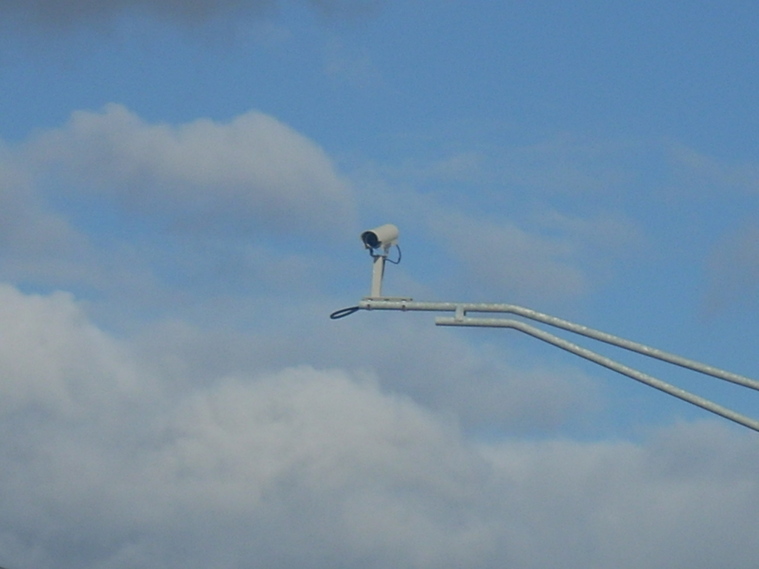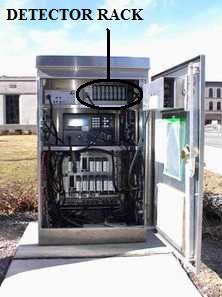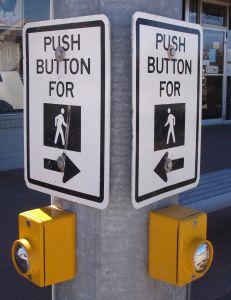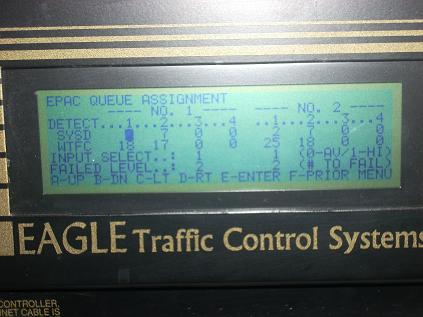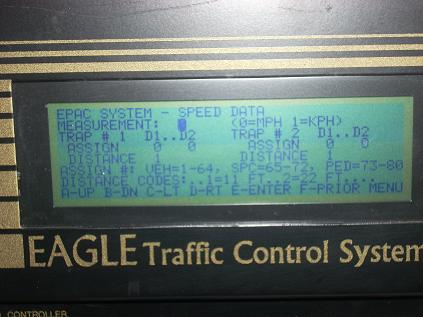Club
Traffic Light II
Vehicle and Pedestrian Detection
Traffic Light II
Vehicle and Pedestrian Detection

At intersections that are semi (partially), or fully (all approaches) actuated, request calls from vehicle inputs select phases routines, detectors are used to pick up calls. Vehicle detection is done in several ways but the two main types are inductance loops and video.
In an inductance loop detection set up, all approaches needing detection will have a square wire cut into the road just in front of the stop line. Inductance wire is routed through the cut square and then filled with tar. When a vehicle passes over the loop, there is a disturbance in the magnetic field which places a call to the controller. Inductance loops work very well, but when subject to changing road conditions, weather, etc. They can be destroyed very easily. Also, improperly calibrated loops can interfere with eachother producing "false calls", or not detect a vehicle at all if set too low. Motorcycles and other vehicles with limited metal on them pose a problem for inductance loop detection. Not enough magnetic disturbance is made.
When a call is placed with an inductance loop, the information is interfaced through a detection rack inside the controller cabinet. the controller picks up the data from the rack and places a call to the appropriate input.
Video Detection works the same way although uses high mount video detection cameras installed at all points that need them. With cameras, only one is needed for each approach, instead of individual ones for lanes. The camera is programmed with software and a video processor within the cabinet to create "zones". Detection calls are placed to the processor and detection rack when vehicles pass through the zone. Cameras have alot more benefits over the older loops, but one disadvantage is the false calls of objects, such as debris, passing into a zone, or a camera that is mis-aimed due to vibration, wear, or weather.
In an inductance loop detection set up, all approaches needing detection will have a square wire cut into the road just in front of the stop line. Inductance wire is routed through the cut square and then filled with tar. When a vehicle passes over the loop, there is a disturbance in the magnetic field which places a call to the controller. Inductance loops work very well, but when subject to changing road conditions, weather, etc. They can be destroyed very easily. Also, improperly calibrated loops can interfere with eachother producing "false calls", or not detect a vehicle at all if set too low. Motorcycles and other vehicles with limited metal on them pose a problem for inductance loop detection. Not enough magnetic disturbance is made.
When a call is placed with an inductance loop, the information is interfaced through a detection rack inside the controller cabinet. the controller picks up the data from the rack and places a call to the appropriate input.
Video Detection works the same way although uses high mount video detection cameras installed at all points that need them. With cameras, only one is needed for each approach, instead of individual ones for lanes. The camera is programmed with software and a video processor within the cabinet to create "zones". Detection calls are placed to the processor and detection rack when vehicles pass through the zone. Cameras have alot more benefits over the older loops, but one disadvantage is the false calls of objects, such as debris, passing into a zone, or a camera that is mis-aimed due to vibration, wear, or weather.
VEHICLE DETECTION
QUEUE, TRAFFIC RESPONSIVE AND SPEED DATA
Detection is not limited to a basic detector unit at the stop line placing calls as the vehicles pull up or drive over. Traffic Responsive detection is related to Queue and Speed Detection. Normally these are done with inductance loops. To collect data two sets of detectors are placed per lane. One at the stop line and one roughly 100 feet before the intersection. The controller calculates the speed or the amount of vehicles approaching the intersection and adjusts the signal coordination accordingly. The controller will report back data of the average speed of vehicles during a coordination plan and the amount of calls placed to the controller in a given time.
NON-LOCKING VS LOCKING, DELAY AND EXTEND
Detection for vehicles can be programmed within the cabinet to be either locking or non-locking among other volume-controlling features. Simply put, a controller set to Non-Lock detection will "forget" calls when they are lost. For example, a vehicle waiting at a red light makes a quick right turn. The controller will not hold the call if the vehicle leaves the detection zone. If it is set to lock than the call remains and the signal cycles at least minimum green timing regardless if the vehicle is still present.
Delay and Extend are two controller programs that do just what they say, either delay or extend the time a call is placed before its lost. If a call is set to delay for a certain time, a controller won't recognize a vehicle is present until the end of the delay time. Extend will hold a call for a given time set after the vehicle leaves the detector.
Delay and Extend are two controller programs that do just what they say, either delay or extend the time a call is placed before its lost. If a call is set to delay for a certain time, a controller won't recognize a vehicle is present until the end of the delay time. Extend will hold a call for a given time set after the vehicle leaves the detector.
PEDESTRIAN DETECTION
Because vehicle detection is variable. Pedestrians are allowed input to the system normally by means of pedestrian call buttons. The buttons are mounted where a pedestrian can easily access them. Pressing them simply places a call to the cabinets pedestrian detector inputs. This allows for a WALK service interval and extends the vehicle green long enough to get pedestrian's across the street. Sometimes pedestrian detectors are equipped with tactile or audible units to help the handicapped or blind cross the street easier.
